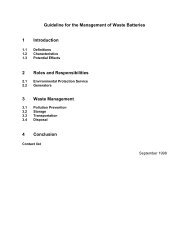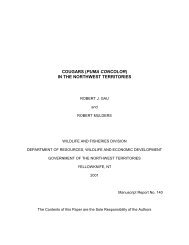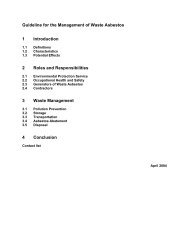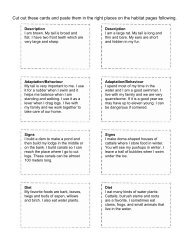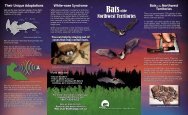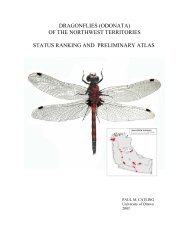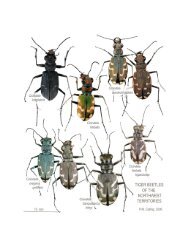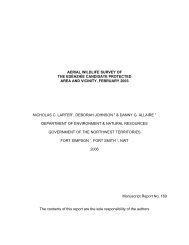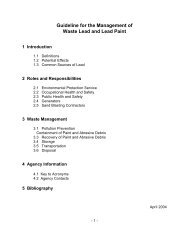Standard Operating Procedure (SOP) - Environment and Natural ...
Standard Operating Procedure (SOP) - Environment and Natural ...
Standard Operating Procedure (SOP) - Environment and Natural ...
- No tags were found...
Create successful ePaper yourself
Turn your PDF publications into a flip-book with our unique Google optimized e-Paper software.
<strong>St<strong>and</strong>ard</strong> <strong>Operating</strong> <strong>Procedure</strong> (<strong>SOP</strong>)<br />
Capture, H<strong>and</strong>ling & Release of Bears<br />
Wildlife Care Committee Primary Author: Dr. Marc Cattet Version 2 - 2011<br />
person administering the drug <strong>and</strong> person providing firearm cover have<br />
cleared the area.<br />
Once the reversal drug is administered, the persons remaining at the bear<br />
must retreat to a safe location to monitor the recovery.<br />
Every effort should be made to observe the animal until it is ambulatory <strong>and</strong><br />
coordinated in its movements.<br />
Bears captured by snare should be observed from a safe distance until<br />
they recover <strong>and</strong> move away from the site. Other bears approaching the<br />
recovering bear <strong>and</strong> snare site should be chased off using noise, unless<br />
they are other members of a family group.<br />
When using non-reversible drug combinations, every effort should be<br />
made to observe the recovering bear until it is ambulatory <strong>and</strong> coordinated<br />
in its movements.<br />
Where a bear has been captured by leg-hold snare, all other active snares<br />
in the area should be removed before the anesthetized bear is<br />
administered reversal drug or left to recover. If snares cannot be<br />
removed, they must be de-activated by closing all snare loops.<br />
When non-anesthetized bears are released from culvert traps, the release<br />
must be triggered remotely or from inside a vehicle.<br />
Persons must not open the trap door while st<strong>and</strong>ing upon the trap.<br />
Helicopters should not leave until the bear is st<strong>and</strong>ing properly.<br />
4.5. Post-Capture Monitoring<br />
Recommendations:<br />
Bear fitted with radio collars should be observed visually at least once<br />
within the three days immediately following capture <strong>and</strong> h<strong>and</strong>ling, <strong>and</strong><br />
ideally within 24 hours of release.<br />
This is especially important if the bear showed any adverse or unusual<br />
response to capture <strong>and</strong> h<strong>and</strong>ling, e.g., hyper- or hypothermia, significant<br />
physical injury. Although animals sometimes die during capture <strong>and</strong><br />
h<strong>and</strong>ling, death may also be delayed occurring within hours to days following<br />
capture (Spraker 1993, Fowler 1995). If an animal dies following capture, the<br />
opportunity to determine cause of death is important for two reasons (Nielsen<br />
1999). First, if the animal died as a direct result of the procedures used<br />
during capture <strong>and</strong> h<strong>and</strong>ling, then a detailed necropsy should be followed by<br />
a review of the capture event <strong>and</strong>, if required, a revision of the methodology<br />
used. Second, if the animal died as a result of a pre-existing illness or<br />
disease exacerbated by the stress of capture <strong>and</strong> h<strong>and</strong>ling, then the detailed<br />
necropsy will help to assure continued confidence in the capture methodology<br />
used <strong>and</strong> may also provide new information regarding the health of the<br />
species.<br />
Ideally, bears should be visualized from high altitude to minimize stress<br />
associated with the noise <strong>and</strong> proximity of the aircraft. However, sighting<br />
a bear where tree cover is extensive may be difficult, if not impossible. In<br />
22



